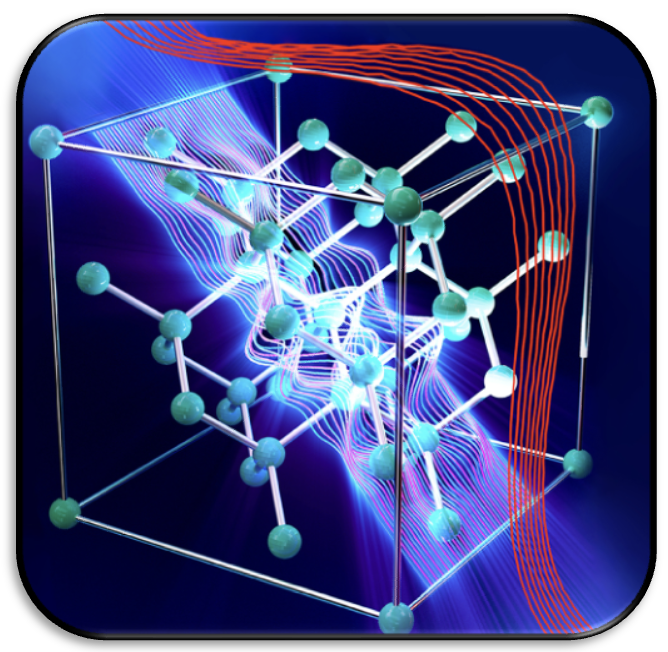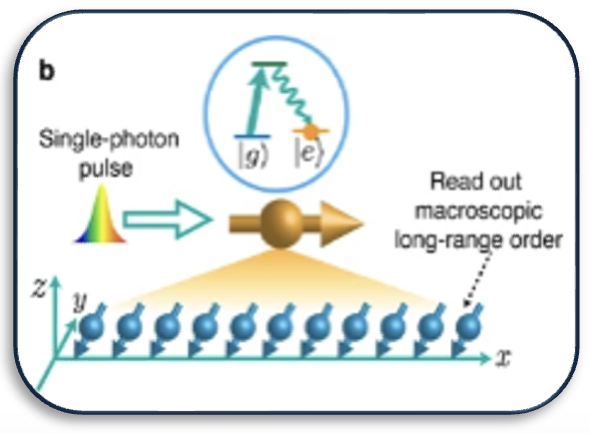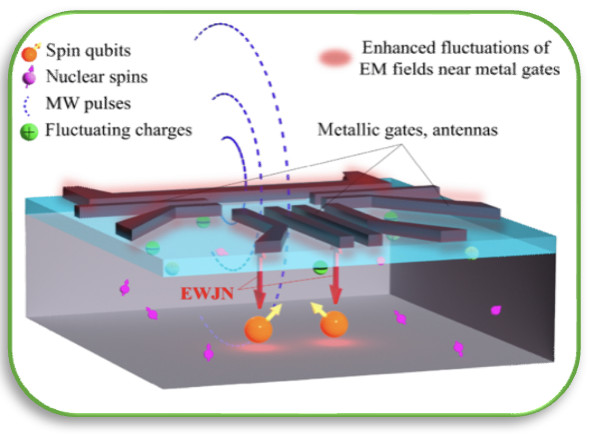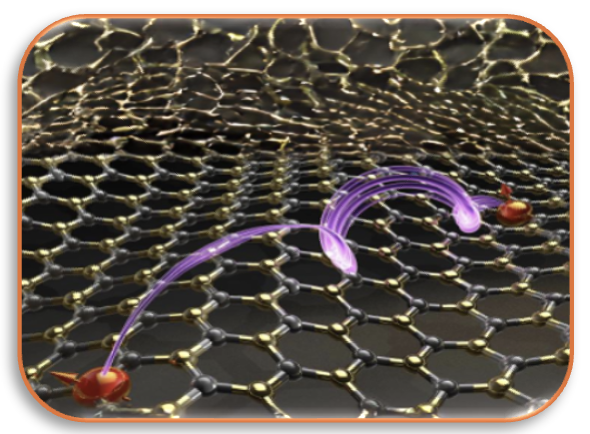Our work in the field of quantum science & engineering spans from theoretical investigations to experimental demonstrations of quantum effects in various light-matter interactions. Following are some of our key contributions to this field.
Click on each tile to know more!
Quantum Detectors & Sensors
Single Photon Driven Quantum Phase Transitions
The temporal dynamics of large quantum systems perturbed weakly by a single excitation can give rise to unique phenomena at the quantum phase boundaries. Here, we develop a time-dependent model to study the temporal dynamics of a single photon interacting with a defect within a large system of interacting spin qubits (N > 100). Our model predicts a quantum resource, giant susceptibility, when the system of qubits is engineered to simulate a first-order quantum phase transition (QPT). We show that the absorption of a single-photon pulse by an engineered defect in the large qubit system can nucleate a single shot quantum measurement through spin noise read-out. This concept of a single-shot detection event (“click”) is different from parameter estimation, which requires repeated measurements. The crucial step of amplifying the weak quantum signal occurs by coupling the defect to a system of interacting qubits biased close to a QPT point. The macroscopic change in long-range order during the QPT generates amplified magnetic noise, which can be read out by a classical device. Our work paves the way for studying the temporal dynamics of large quantum systems interacting with a single-photon pulse.

Single Photon Interaction with Superconducting Vortices
Superconducting nanowire single-photon detectors have emerged as a promising technology for quantum metrology from the mid-infrared to ultraviolet frequencies. Despite recent experimental successes, a predictive model to describe the detection event in these detectors is needed to optimize the detection metrics. Here, we propose a probabilistic criterion for single-photon detection based on single-vortex (flux quanta) crossing the width of the nanowire. Our model makes a connection between the dark counts and photon counts near the detection threshold. The finite-difference calculations demonstrate that a change in the bias current distribution as a result of the photon absorption significantly increases the probability of single-vortex crossing even if the vortex potential barrier has not vanished completely. We estimate the instrument response function and show that the timing uncertainty of this vortex tunneling process corresponds to a fundamental limit in timing jitter of the click event. We demonstrate a trade-space between this intrinsic (quantum) timing jitter, quantum efficiency, and dark count rate in TaN, WSi, and NbN superconducting nanowires at different experimental conditions. Our detection model can also explain the experimental observation of exponential decrease in the quantum efficiency of SNSPDs at lower energies. This leads to a pulse-width dependency in the quantum efficiency, and it can be further used as an experimental test to compare across different detection models.
Computational EM Meets Spin Qubits
High-fidelity quantum gate operations are essential for achieving scalable quantum circuits. In spin qubit quantum computing systems, metallic gates and antennas that are necessary for qubit operation, initialization, and readout, also cause detrimental effects by enhancing fluctuations of electromagnetic fields. Therefore, evanescent wave Johnson noise (EWJN) caused by near-field thermal and vacuum fluctuations becomes an important unmitigated noise, which induces the decoherence of spin qubits and limits the quantum gate operation fidelity. Here, we first develop a macroscopic quantum electrodynamics theory of EWJN to account for the dynamics of two spin qubits interacting with metallic circuitry. Then we propose a numerical technique based on volume integral equations to quantify EWJN strength in the vicinity of nanofabricated metallic gates with arbitrary geometry. We study the limits to two-spin-qubit gate fidelity from EWJN-induced relaxation processes in two experimentally relevant quantum computing platforms: (a) the silicon quantum dot system and (b) nitrogen-vacancy centers in diamond. Finally, we introduce a Lindbladian engineering method to optimize the control pulse sequence design and show its enhanced performance over Hamiltonian engineering in mitigating the influence of thermal and vacuum fluctuations. Our work leverages advances in computational electromagnetics, fluctuational electrodynamics, and open quantum systems to suppress the effects of near-field thermal and vacuum fluctuations and reach the limits of two-spin-qubit gate fidelity.
Superdephasing in Collective Atom-Atom Interactions
Pure dephasing and spontaneous emission are two non-unitary processes of atoms or spins inter- acting with fluctuating electromagnetic (EM) modes. The dissipative collective emission processes (e.g., superradiance) originate from interactions with EM modes in resonance with atoms and have received considerable attention. Meanwhile, the analogous non-dissipative collective dephasing phe- nomena mediated by EM environments remain poorly understood. Here, we introduce the nano-EM super-dephasing phenomenon arising in the photonic environments near materials. We show that collective dephasing in this nano-EM environment is enhanced by over 10 orders of magnitude com- pared to free space or cavities. This giant enhancement originates from long-range correlations in off-resonant, low-frequency evanescent EM fluctuations, which lead to collectively accelerated (super-) or suppressed (sub-) dephasing in many-body entangled states. We further unravel that nano-EM collective dephasing exhibits universal interaction ranges near materials with different anisotropy that can be reciprocal or non-reciprocal. This nano-EM interaction range, which is not present in free-space and cavities, leads to unique scaling laws of super-dephasing in GHZ states dif- ferent from the conventional N2 scaling of superradiance. Finally, we discuss how to experimentally isolate and control super-dephasing to open interesting frontiers for scalable quantum systems.

Unravelling Deep Microscopic Quantum Optical Polarization
Nanophotonics, which deals with the study of light-matter interaction at scales smaller than the wavelength of radiation, has widespread applications from plasmonic waveguiding, topological photonic crystals, super-lensing, solar absorbers, and infrared imaging. The physical phenomenagoverning these effects can be captured by using a macroscopic homogenized quantity called the refractive index. However, the lattice-level description of optical waves in a crystalline material using a quantum theory has long been unresolved. Inspired by the dynamics of electron waves and their corresponding band structure, here, we put forth a pico-optical band theory of solids which reveals waves hidden deep within a crystal lattice. We show that these hidden waves arise from optical pico-indices, a family of quantum functions obeying crystal symmetries, and cannot be described by the conventional concept of refractive index. We present for the first time- the hidden waves and pico-optical band structure of 14 distinct materials. We choose Si, Ge, InAs, GaAs, CdTe, and others from Group IV, III-V, and II-VI due to their technological relevance but our framework is readily applicable to a wide range of emerging 2D and 3D materials. In stark contrast to the macroscopic refractive index of these materials used widely today, this picophotonic framework shows that hidden waves exist throughout the crystal lattice and have unique pico-polarization texture and crowding. We also present an open-source software package, Purdue-PicoMax, for the research community to discover hidden waves in new materials like hBN, graphene, and Moire materials. Our work establishes a foundational crystallographic feature to discover novel pico-optical waves in light-matter interaction.
Vacuum Friction and Casimir Forces
Resonators fold the path of light by reflections leading to a phase balance and thus constructive addition of propagating waves. However, amplitude decrease of these waves due to incomplete reflection or material absorption leads to a finite quality factor of all resonances. Here we report on our discovery that evanescent waves can lead to a perfect phase and amplitude balance causing an ideal Fabry-Perot resonance condition in spite of material absorption and non-ideal reflectivities. This counterintuitive resonance occurs if and only if the metallic Fabry-Perot plates are in relative motion to each other separated by a critical distance. We show that the energy needed to approach the resonance arises from the conversion of the mechanical energy of motion to electromagnetic energy. The phenomenon is similar to lasing where the losses in the cavity resonance are exactly compensated by optical gain media instead of mechanical motion. Nonlinearities and non-localities in material response will inevitably curtail any singularities however we show the giant enhancement in non-equilibrium phenomena due to such resonances in moving media.
Topological Optical N-Insulators
Topological phases of matter arise in distinct fermionic and bosonic flavors. The fundamental differences between them are encapsulated in their rotational symmetries—the spin. Although spin quantization is routinely encountered in fermionic topological edge states, analogous quantization for bosons has proven elusive. To this end, we develop the complete electromagnetic continuum theory characterizing 2+1D topological bosons, taking into account their intrinsic spin and orbital angular momentum degrees of freedom. We demonstrate that spatiotemporal dispersion (momentum and frequency dependence of linear response) captures the matter-mediated interactions between bosons and is a necessary ingredient for topological phases. We prove that the bulk topology of these 2+1D phases is manifested in transverse spin-1 quantization of the photon. From this insight, we predict two unique bosonic phases—one with even parity C=±2 and one with odd C=±1. To understand the even parity phase C=±2, we introduce an exactly solvable model utilizing nonlocal optical Hall conductivity and reveal a single gapless photon at the edge. This unidirectional photon is spin-1 helically quantized, immune to backscattering, defects, and exists at the boundary of the C=±2 bosonic phase and any interface-even vacuum. The contrasting phenomena of transverse quantization in the bulk, but longitudinal (helical) quantization on the edge is addressed as the quantum gyroelectric effect. We also validate our bosonic Maxwell theory by direct comparison with the supersymmetric Dirac theory of fermions. To accelerate the discovery of such bosonic phases, we suggest two probes of topological matter with broken time-reversal symmetry: momentum-resolved electron energy-loss spectroscopy and cold atom near-field measurement of nonlocal optical Hall conductivity.







